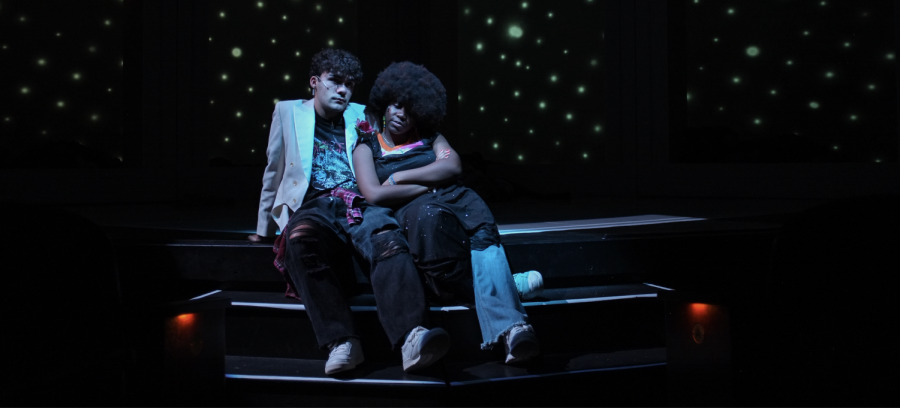‘Sanctuary City’: The Harsh Realities of the American Dream
Colgate’s Department of Theater presented Martyna Majok’s “Sanctuary City,” at the Brehmer Theater in Dana Arts Center from Nov. 11 to 15. The play, directed by Professor of Theater Adrian Giurgea, starred first-year Dani Makielo as G, sophomore Jorge Rochet as B and sophomore Graham Johnson as Henry. Sometimes hopeful, sometimes heart-wrenching and always poignant, the play tells the story of friends B and G (short for “boy” and “girl”), as they fight to survive as undocumented immigrants in post-9/11 America.
Due to their undocumented status, B & G face hardships and uncertainty at every turn, from exploitation in the workplace to domestic abuse to anxiety over being detained in the nightmarish Fishkill Correctional Facility. However, despite these challenges, B & G’s lives are made bright by the love and support they provide for one another. The two share everything with each other, from hopes and dreams to the fur coat that they use as a comforter on their twin bed. In one scene, huddled together under the coat, B & G repeatedly exchange a simple phrase with one another: “It’s cold.” While this line is referring to the harsh Newark wintertime, it is also a reference to their status as immigrants in a world that seems determined to ice them out.
While at first, B & G’s bond appears unbreakable, the dynamic of their friendship shifts when G’s mother unexpectedly obtains citizenship, thus passing citizen status onto G herself. Suddenly, G’s citizenship has opened up a whole new world for her while B finds himself trapped in his lack of citizenship, plagued by anxiety, uncertainty, and limited opportunity. While G and B strive to remain friends, the shift in their dynamic is clear and the strain on their relationship only grows.
Just one of the ways that the play conveys these growing tensions is through its ingenious staging. While the set itself consists of only a simple white and black frame, sparse props such as a heap of clothes or a bottle of wine and a canvas backdrop onto which images connected to the storyline were projected. The way these elements are used makes their impact far greater than the props themselves. Using the projections, for instance, the stage is transformed time and again, often shifting multiple times a minute in order to keep pace with the rapidly changing scenes.
In one moment, the screens might be displaying the misty streets of Newark; in the next, it might be filled entirely with B and G’s dialogue written out in scrawling handwriting. Each backdrop seems to have been carefully selected and timed within the events of the play to enhance the intensity of whatever the characters are experiencing.
“I was blown away by the simultaneous simplicity and power of the staging,” remarked sophomore Becca Ryan. “Even though there were very few physical props on stage, the ever-changing backdrop conveyed a sea of emotions and a whole world within B’s bedroom.”
Perhaps one of the most memorable scenes took place towards the end of the second act when G and B attend their senior prom for one last night before G leaves for college. Dressed in their ordinary clothes but with their respective white tuxedo and shimmering black dress pulled over the top, B & G danced the night away to early 2000s classics like Avril Lavigne’s “Sk8er Boi” and The Killers’ “Mr. Brightside”. At one point, their wild dancing takes them into the audience where they continue to jump and thrash just inches from those seated on the aisle.
Exhausted, the two collapse on the subway ride home and have a drink together while talking about their friendship. In a moment of passion, the two come up with a plan to solve B’s citizenship problem: they will get married. One pinky promise later, the plan has become real and, in B and G’s minds, will solve all their problems by granting B citizenship and keeping their relationship strong while G is away at college. This hope, however, cannot last.
In the second half of the play, B & G’s relationship takes a turn for the worse as hidden love, festering resentment and lifelong secrets all come to light. While it would be a tragedy to reveal too much about the revelations and irreversible decisions reached by characters during this climax, what would be an even greater tragedy would be to not commend the incredible performance of sophomore Graham Johnson in his role as Henry. While Henry, an acquaintance of B, only emerges as a character in Act II, he quickly takes center stage as a main character and becomes a driving force of conflict for the remainder of the play. Expertly garnering the audience’s pity, respect and ire in equal measure, Johnson keeps the audience conflicted and on the edge of their seats, ultimately forcing the show to its uneasy resolution.
As audience members trickled out of Brehmer Theater after the show, the ongoing hardships of the characters lingered with them. The tension foreboding among the audience members can perhaps be attributed to one simple fact: “America has not fixed itself and America has not corrected the problem,” said Majok, the writer behind the play.
“The characters are fighting for their lives and for their dignity in a country with a policy that does not want them. It’s an impossible situation.”






